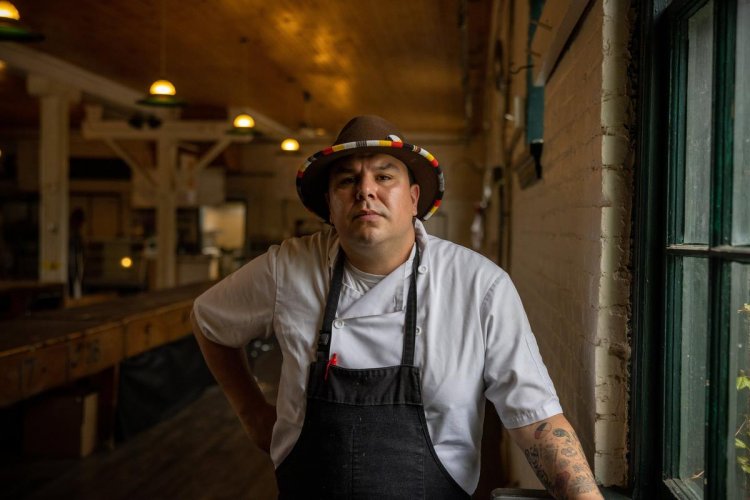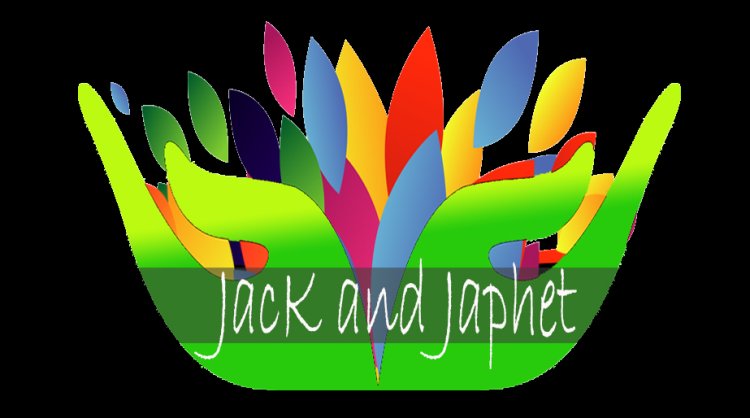This chef’s ‘progressive Aboriginal’ cooking is worth the drive to Owen Sound
Chef Zach Keeshig is pulling long tapering leaves called cattails. They shoot out from the riverbed inside Harrison Park, near Georgian Bay. It’s a rainy June day and he’s doing what he does often: foraging. Within a quarter kilometre, he has foraged a half dozen ingredients for his current tasting menu at a weekend supper club he runs out of the Owen Sound Farmers’ Market.“Now that spring is here, I am constantly out foraging,” Keeshig said, while peeling the cattail root, trimming away at the branches to reveal the rhizome. “It has an almost cucumber flavour, there’s also a medicinal quality. You can rub it on like aloe vera.”In addition to the cattail, there’s watercress that reminds me of muzina (Japanese mustard greens) and forget-me-nots that Keeshig likes to use to accent his dishes — pheasant back mushrooms that when cut smell like watermelon rinds.“You can braise them or cook them down in a soup,” said Keeshig. One of his favourite ingredients right now is wild ginger, of which he has fistfuls. “I use this instead of store-bought ginger,” said Keeshig. The thin roots have a pronounced perfume note. It’s more floral, reminiscent of lemongrass. “I’m using this in my fish course right now, fish and ginger is a perfect marriage.” For the past seven years, starting in the spring, Keeshig and his managing partner Lisa Lobsinger have been taking over the Owen Sound Farmers’ Market every Saturday after it closes its door.“We basically rearrange this room, moving all the tables out of the way to create an intimate scene for our diners,” said Lobsinger.Keeshig hosts his Naagan dinner series Saturday and Sunday nights, primarily relying on his social media following to fill the 13 tables. It’s a serene and tranquil scene in the more than 150-year-old market’s café space, overlooking the Sydenham River, an inlet of Georgian Bay on Lake Huron. “My goal as a chef is to inform people about our surroundings, the ingredients that grow all around us,” said Keeshig.For his intimate dinner series, Keeshig crafts a nine-course tasting menu, that consists of what he calls “progressive Aboriginal cuisine.” He sees the menu as a way to weave his culinary experience working in some of the province’s top kitchens with his philosophy of reconnecting to the land via hyper-seasonal ingredients — many of which he forages himself. “We always try to make sure each dish has at least one foraged element, whether it’s fresh from the season, or something from the larder that I have preserved from the year before,” said Keeshig.Keeshig, who was born on Cape Croker Indian Reserve, was attending culinary school in Owen Sound when his brother introduced him to foraging. “We would go picking for morels with his friends,” recalled Keeshig. “He hooked me on the idea of paying attention to my surroundings.”After culinary school, Keeshig worked at a number of high-profile restaurants in the province including Langdon Hall in Cambridge and Pearl Morissette in the Niagara region. He also spent some time working with chef Michael Stadtlander on his Eigensinn Farm. “So there’s a lot of classic French approach in the way I cook, and I try to incorporate art as much as possible. I like to see the expression on people’s faces when they see the dishes, or see me finish plating,” said Keeshig. “But the foundation is the idea of foraging and seasonal ingredients.”While foraging plays a key role in Keeshig’s cooking, supporting local producers and farmers is also equally important. “The pandemic was hard on all of us here,” he said. “But I also noticed that people were leaning toward convenience by shopping at big box stores when we have so many great farmers around us that were crying for support.”Over 90 per cent of the ingredients on his menu are locally sourced, according to Keeshig. “Chocolate is the only ingredient that is not local, but I’m going to be removing that from our menu.”He sources organic flour from a nearby mill outside of Owen Sound. The wildflower honey comes from a producer at the farmers’ market. And with Georgian Bay at his doorstep, Keeshig sources his fish from a local Indigenous fisherman.“I have access to the freshest fish possible, so I am going to use it as much as I can,” said Keeshig.So, what’s it like to sit down for dinner at Naagan?For his current main course, Keeshig is serving salmon from Robichaud Commercial Fishing. Lobes of salmon are cooked in the classic French style, en papillote, where the fish is wrapped in a paper pouch and prepared in a combination cooking method that steams and bakes at the same time.Keeshig doesn’t use any liquid to cook the fish, instead he opts for butter. The fish is lightly brushed with locally foraged sumac and dill. “Sumac is a really important ingredient for our people. We would steep it in cold water to make tea, sweetening it with honey or maple syrup. I find that it accents fish really well,” said Keeshig. When the salmon is finished, it’s tender and delicate. A thin layer of pi


Chef Zach Keeshig is pulling long tapering leaves called cattails. They shoot out from the riverbed inside Harrison Park, near Georgian Bay.
It’s a rainy June day and he’s doing what he does often: foraging.
Within a quarter kilometre, he has foraged a half dozen ingredients for his current tasting menu at a weekend supper club he runs out of the Owen Sound Farmers’ Market.
“Now that spring is here, I am constantly out foraging,” Keeshig said, while peeling the cattail root, trimming away at the branches to reveal the rhizome. “It has an almost cucumber flavour, there’s also a medicinal quality. You can rub it on like aloe vera.”
In addition to the cattail, there’s watercress that reminds me of muzina (Japanese mustard greens) and forget-me-nots that Keeshig likes to use to accent his dishes — pheasant back mushrooms that when cut smell like watermelon rinds.
“You can braise them or cook them down in a soup,” said Keeshig.
One of his favourite ingredients right now is wild ginger, of which he has fistfuls.
“I use this instead of store-bought ginger,” said Keeshig. The thin roots have a pronounced perfume note. It’s more floral, reminiscent of lemongrass. “I’m using this in my fish course right now, fish and ginger is a perfect marriage.”
For the past seven years, starting in the spring, Keeshig and his managing partner Lisa Lobsinger have been taking over the Owen Sound Farmers’ Market every Saturday after it closes its door.
“We basically rearrange this room, moving all the tables out of the way to create an intimate scene for our diners,” said Lobsinger.
Keeshig hosts his Naagan dinner series Saturday and Sunday nights, primarily relying on his social media following to fill the 13 tables. It’s a serene and tranquil scene in the more than 150-year-old market’s café space, overlooking the Sydenham River, an inlet of Georgian Bay on Lake Huron.
“My goal as a chef is to inform people about our surroundings, the ingredients that grow all around us,” said Keeshig.
For his intimate dinner series, Keeshig crafts a nine-course tasting menu, that consists of what he calls “progressive Aboriginal cuisine.”
He sees the menu as a way to weave his culinary experience working in some of the province’s top kitchens with his philosophy of reconnecting to the land via hyper-seasonal ingredients — many of which he forages himself.
“We always try to make sure each dish has at least one foraged element, whether it’s fresh from the season, or something from the larder that I have preserved from the year before,” said Keeshig.
Keeshig, who was born on Cape Croker Indian Reserve, was attending culinary school in Owen Sound when his brother introduced him to foraging.
“We would go picking for morels with his friends,” recalled Keeshig. “He hooked me on the idea of paying attention to my surroundings.”
After culinary school, Keeshig worked at a number of high-profile restaurants in the province including Langdon Hall in Cambridge and Pearl Morissette in the Niagara region. He also spent some time working with chef Michael Stadtlander on his Eigensinn Farm.
“So there’s a lot of classic French approach in the way I cook, and I try to incorporate art as much as possible. I like to see the expression on people’s faces when they see the dishes, or see me finish plating,” said Keeshig. “But the foundation is the idea of foraging and seasonal ingredients.”
While foraging plays a key role in Keeshig’s cooking, supporting local producers and farmers is also equally important.
“The pandemic was hard on all of us here,” he said. “But I also noticed that people were leaning toward convenience by shopping at big box stores when we have so many great farmers around us that were crying for support.”
Over 90 per cent of the ingredients on his menu are locally sourced, according to Keeshig.
“Chocolate is the only ingredient that is not local, but I’m going to be removing that from our menu.”
He sources organic flour from a nearby mill outside of Owen Sound. The wildflower honey comes from a producer at the farmers’ market. And with Georgian Bay at his doorstep, Keeshig sources his fish from a local Indigenous fisherman.
“I have access to the freshest fish possible, so I am going to use it as much as I can,” said Keeshig.
So, what’s it like to sit down for dinner at Naagan?
For his current main course, Keeshig is serving salmon from Robichaud Commercial Fishing. Lobes of salmon are cooked in the classic French style, en papillote, where the fish is wrapped in a paper pouch and prepared in a combination cooking method that steams and bakes at the same time.
Keeshig doesn’t use any liquid to cook the fish, instead he opts for butter. The fish is lightly brushed with locally foraged sumac and dill.
“Sumac is a really important ingredient for our people. We would steep it in cold water to make tea, sweetening it with honey or maple syrup. I find that it accents fish really well,” said Keeshig.
When the salmon is finished, it’s tender and delicate. A thin layer of pickled asparagus ends are placed on top of the fish to mimic fish scales, along with some foraged watercress.
For the sauce, Keeshig sweats some onions in fish stock and reduces it down to a demi-glace, and then bulks it with cream and wild ginger.
Keeshig also makes an “Indigenized” sourdough loaf, using wild rice, pumpkin seed, golden flax and sunflower seeds. Slices are charred over an open flame, and layered with chunks of smoked salmon, topped with quenelles of strained yoghurt.
“I fold in some foraged stinging nettles into the yoghurt,” he said.
The salmon has a pronounced smoky quality on its tender flesh, complemented by the yoghurt, which is reminiscent of labneh, with the wild spinach notes of the nettles.
The farmers’ market also plays a crucial role in how Keeshig sources his ingredients.
“During the pandemic, we’ve seen new farmers that have started micro-operations. There’s always something new, which is a good sign,” said Keeshig.
Keeshig sources duck eggs from a local farmer, which he currently uses to make ice cream with the yolks, sweetening them with local honey and flavouring them with sweetgrass.
“We would smudge sweetgrass when I was younger, it reminds me of woodruff. I had a hard time sourcing it until I met someone that grows it here.”
The ice-cream bars arrive with a small bushel of sweetgrass that Keeshig lights tableside. The perfume, almost vanilla in essence, quickly fills up the room.
The ice cream has a luxurious creaminess to it, richness from the duck egg yolks.
“I’ve saved the egg whites, I’ll be using them to make macarons, which I’ll serve with some sponge toffee made with maple syrup and buckwheat honey,” said Keeshig.
Suresh Doss is a Toronto-based food writer and food tour guide. He is a freelance contributor to the Star. Reach him via email: suresh.doss@gmail.com




















